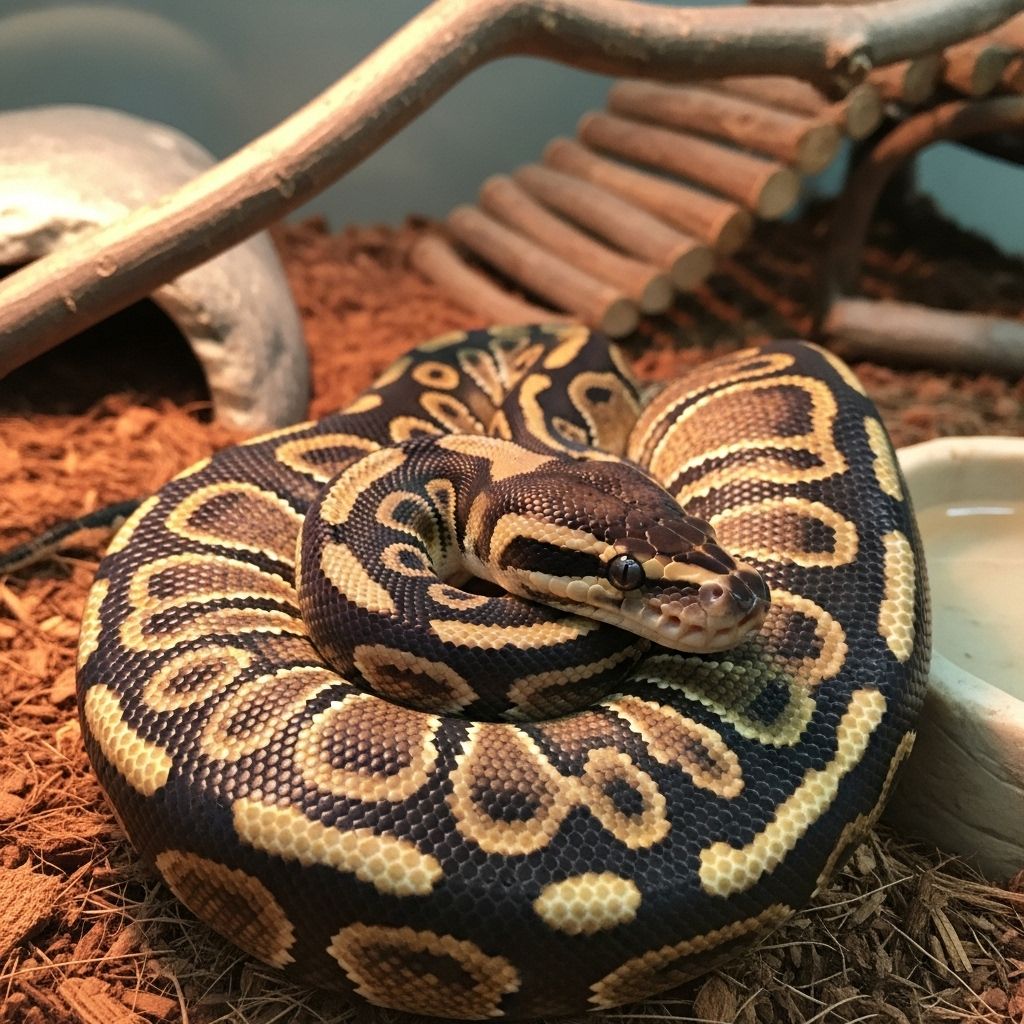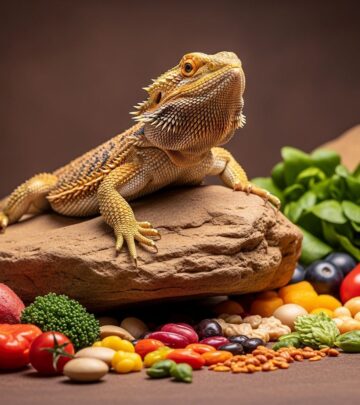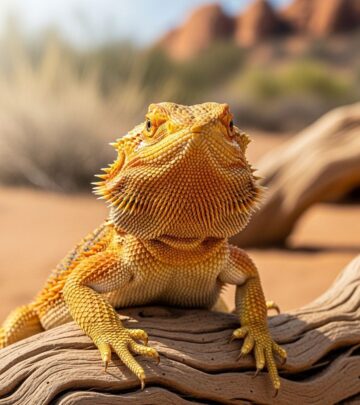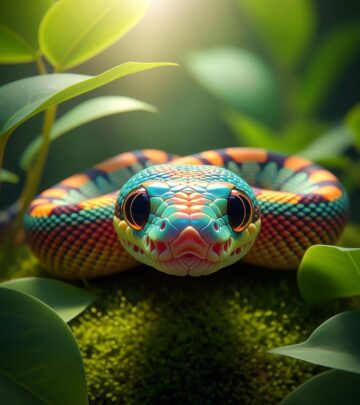Ball Python Care Guide: Habitat, Health, and Ownership Tips
Precise habitats and routines ensure a content, confident reptile companion.

Ball Python Care Guide: Essential Information for Owners
Ball pythons (Python regius) are among the most popular snakes for beginner reptile enthusiasts and long-time keepers alike, cherished for their docile nature, manageable size, and fascinating behaviors. Native to western and central Africa, these snakes thrive in captivity when provided with appropriate care, including suitable housing, proper temperature and humidity, and a nutritious diet. This guide provides a detailed overview of everything you need to successfully keep and care for a ball python, drawing on best practices and expert advice.
Overview of Ball Pythons
Ball pythons are named for their habit of curling into a tight ball when threatened, hiding their head in the center. They are non-venomous constrictors, and their relatively small adult size makes them suitable for home enclosures.
- Common names: Ball python, royal python
- Scientific name: Python regius
- Adult size: 3–5 feet (males tend to be smaller, females can reach up to 6 feet)
- Lifespan: 20–30 years on average; some individuals live beyond 40 years
- Level of care: Beginner to intermediate
- Temperament: Generally shy, calm, and easy to handle when acclimated
Setting Up the Enclosure
Providing a secure, appropriately-sized enclosure is a fundamental aspect of ball python care. Enclosure size, material, security, and accessories all play a role in your snake’s well-being.
Enclosure Size and Security
- Minimum size for adults: 40-gallon tank, or a 4′ x 2′ x 2′ enclosure works well.
- Juveniles: Smaller enclosures can help them feel more secure. A simple 20-gallon terrarium is often sufficient, upgraded as the snake grows.
- Security: Ball pythons are adept escape artists. Always use a secure, locking lid or sliding doors.
Material Considerations
- PVC enclosures: Lightweight, maintain humidity well, easy to clean.
- Glass tanks: Widely available, but can be heavy. Glass also tends to lose humidity; cover three sides of the tank for privacy and to reduce stress.
- Avoid porous woods: Some woods emit toxic fumes or are difficult to disinfect.
Environmental Enrichment and Decor
- Hides: Provide at least two – one on the cool side, one on the warm side. Ball pythons are secretive and appreciate tight, dark hiding places. Commercial or homemade (half log, clay pot, plastic hide) options are suitable.
- Climbing surfaces: While primarily terrestrial, young ball pythons enjoy low branches and sturdy clutter for exploration.
- Substrate: Aspen shavings, coconut husk, cypress mulch, and paper towels are all suitable. Avoid cedar and pine, as they can be toxic.
- Plants and decor: Artificial or clean, non-toxic real plants add enrichment. Covering three of four enclosure walls with black paper or cloth can increase feelings of safety.
Temperature and Humidity Requirements
Ball pythons require precise temperature gradients and moderate humidity to stay healthy. Proper temperature and humidity help regulate appetite, digestion, immune function, and shedding.
Temperature and Heating
- Ambient (background) temperature: 78–80°F (25–27°C)
- Warm side/basking spot: 88–96°F (31–35°C)
- Cool side: 76–80°F (24–27°C)
- Nighttime minimum: No lower than 75°F (24°C)
- Heating methods: Under-tank heaters (UTH), heat tape, ceramic heat emitters, radiant heat panels. All heating elements should be regulated by a thermostat to prevent burns.
- Monitoring: Use digital thermometers with probes on both cool and warm sides, or a temperature gun for spot checks.
Humidity Control
- Ideal humidity: 55–65%
- During shedding: Increase temporarily to 65–75% to promote healthy shed.
- Humidity tools: Digital hygrometer, daily misting with distilled water, large water bowl, and use of a humid hide (a hide box filled with damp sphagnum moss).
- Bioactive setups: Living plants help maintain humidity and provide enrichment.
Lighting
Ball pythons do not require UVB lighting but benefit from a regular day-night cycle.
- Photoperiod: Provide 12 hours of light and 12 hours of darkness daily. Regular household or LED bulbs can be used for visibility and routine.
- Optional UVB: While not essential, low levels of UVB (2.0–5.0) may offer health benefits and support natural behavior, especially in bioactive enclosures.
Ball Python Diet and Feeding
Ball pythons are obligate carnivores, feeding almost exclusively on appropriately sized rodents in captivity. The right feeding regimen is crucial for health and well-being.
What to Feed
- Food items: Mice or rats, offered frozen-thawed or freshly killed (never live, to prevent injury to the snake).
- Size: Prey width should equal the widest part of the snake’s body.
- Feeding schedule:
- Hatchlings: Every 5–7 days
- Juveniles: Every 7–10 days
- Adults: Every 10–14 days
- Feeding tips: Feed in the enclosure or a separate bin; if feeding outside the enclosure, handle gently to reduce stress. Do not handle your ball python for at least 24–48 hours after feeding to avoid regurgitation.
Hydration
- Water bowl: Provide fresh, clean water at all times. Use a heavy, shallow bowl large enough for soaking. Replace water daily and disinfect the bowl weekly.
- Soaking: Ball pythons may soak when preparing to shed or to regulate body temperature. Clean the bowl immediately if soiled.
Shedding
Ball pythons regularly shed their skin, and a successful shed is a sign of good husbandry.
- Frequency: Every 4–8 weeks for juveniles; less frequent in adults.
- Signs of shedding: Dull or bluish skin, opaque/blue eyes, reduced activity.
- Supportive care: Boost enclosure humidity, provide a humid hide, and avoid handling during this period.
- Check after shed: Ensure the shed is complete, including retained eye caps (“spectacles”) and tail tip. A stuck shed may require gentle soaking and removal.
Enclosure Maintenance and Cleaning
Keep your ball python’s habitat clean to prevent health problems.
- Spot clean daily: Remove feces, urates, and soiled substrate as needed.
- Deep clean monthly: Remove the snake, substrate, and accessories. Disinfect the enclosure and decor with a 5% household bleach solution or reptile-safe disinfectant. Rinse thoroughly and allow to dry before replacing your snake.
- Water dish hygiene: Clean weekly (or when soiled) to prevent bacteria buildup.
Temperament and Handling
Ball pythons are generally docile but can be shy and anxious, especially in new environments. Regular, gentle handling helps build trust.
- Initial interactions: Allow your snake to acclimate to new surroundings before frequent handling.
- Handling technique: Support the snake’s entire body, move slowly, and avoid sudden movements. Never grab from above, as this mimics predator behavior.
- Biting risk: Stress, hunger, or fear may cause defensive behavior. If your snake seems agitated (hissing, coiling tightly, or striking posture), give it space and time to relax.
- After feeding: Wait at least 24–48 hours post-feeding before handling to help the snake digest and prevent regurgitation.
- Children and ball pythons: Supervise all interactions; teach gentle, respectful handling.
Common Health Issues
Proper care minimizes health problems, but ball pythons may occasionally develop illnesses that require swift attention.
- Respiratory infections: Symptoms include open-mouth breathing, wheezing, mucus, and bubbling from the nose. Usually caused by low temperatures, poor humidity, or dirty enclosures. Seek veterinary care.
- Stuck shed (dysecdysis): Most often due to low humidity. Provide a humid hide and increase ambient humidity.
- Mouth rot (infectious stomatitis): Red, swollen mouth with pus or discoloration. Emergency treatment needed.
- Mites and external parasites: Visible as black dots or cause irritated behavior. Consult an exotic animal veterinarian for treatment; thorough habitat cleaning is essential.
- Refusing food: Common and not always a concern, especially during seasonal changes, shed cycles, or environmental stress. Persistent refusal (over 1–2 months in adults, or rapid weight loss) warrants veterinary evaluation.
Choosing and Acclimating a Ball Python
Careful selection and proper acclimation are key to a successful pet ownership experience.
- Source: Purchase captive-bred animals from reputable breeders or rescues. Wild-caught pythons are prone to stress and disease.
- Age: Both juveniles and adults make good pets; juveniles require smaller prey and more frequent feeding.
- First enclosure: Have all supplies ready before bringing home your new pet. Allow a minimum of one week for the snake to acclimate, handling only as needed for husbandry or emergency checks.
Recommended Supplies Checklist
- Secure enclosure (preferably front-opening with secure locks)
- Appropriate substrate (aspen, coconut fiber, cypress mulch, or paper towels)
- At least two hides (warm and cool sides)
- Large, shallow water bowl
- Thermostat-controlled heat source
- Digital thermometers and hygrometer
- Misting bottle (distilled water)
- Decorative items (logs, branches, artificial plants)
- Spare water bowl for easy rotation
- Rodent food supply (appropriately sized; frozen-thawed recommended)
Frequently Asked Questions (FAQs)
Q: Are ball pythons good for beginners?
A: Yes, ball pythons are considered one of the best pet snakes for beginners due to their calm temperament, manageable size, and relatively simple care requirements.
Q: How often should I handle my ball python?
A: Start with short, gentle handling sessions once or twice a week and increase as the snake becomes comfortable. Avoid handling for at least 24–48 hours after feeding or during a shed.
Q: Why is my ball python refusing to eat?
A: Occasional fasting is normal, especially during stress, cooler seasons, or before shedding. If refusal persists for several weeks and is accompanied by weight loss or lethargy, consult a reptile veterinarian.
Q: How can I tell if my ball python is healthy?
A: Healthy ball pythons are alert, have bright eyes, clear nostrils, and smooth, unbroken skin. Good body weight and consistent shedding cycles are positive signs. Look out for lethargy, weight loss, stuck sheds, or discharge from the mouth or nose.
Q: Can ball pythons be kept together?
A: Generally, ball pythons should be housed individually except for breeding purposes. Cohabitation can cause stress, competition, and potential injury.
Summary Table: Ball Python Care at a Glance
| Aspect | Key Requirement |
|---|---|
| Enclosure Size | 40+ gallons for adults; smaller for juveniles |
| Temperature | 78–80°F (ambient), 88–96°F (basking spot) |
| Humidity | 55–65% standard, 70% during shed |
| Diet | Appropriately sized mammals, every 7–14 days |
| Lifespan | 20–30 years, up to 40+ |
| Temperament | Docile, shy, calm |
| Lighting | 12h light/12h dark cycle; UVB optional |
Final Tips for Ball Python Owners
- Conduct regular habitat checks to maintain optimal temperature and humidity.
- Watch for changes in behavior, appetite, or appearance.
- Only purchase from reputable breeders or rescues.
- Research local exotic reptile veterinarians before an emergency arises.
- Remember, with proper care, your ball python can thrive for decades!
References
- https://www.hvreptilerescue.org/resources/care-guides/ball-python-care-guide
- https://www.thebiodude.com/blogs/snake-caresheets/ball-python-care-guide
- https://reptilesmagazine.com/ball-python-care-sheet/
- http://www.exoticpetvet.com/ball-python-care.html
- https://reptifiles.com/ball-python-care-guide/
- https://community.morphmarket.com/t/ball-python-care-guide/39828
- https://www.youtube.com/watch?v=te48P2Ilq5M
Read full bio of Sneha Tete












